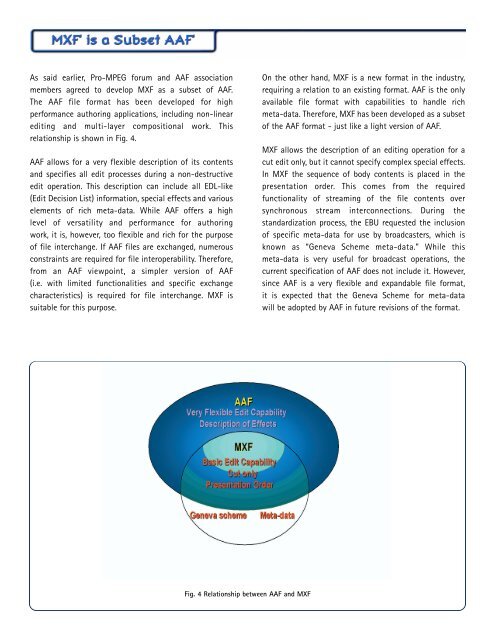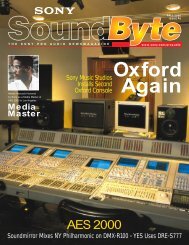24757 MXF White Paper v2
24757 MXF White Paper v2
24757 MXF White Paper v2
- No tags were found...
Create successful ePaper yourself
Turn your PDF publications into a flip-book with our unique Google optimized e-Paper software.
As said earlier, Pro-MPEG forum and AAF associationmembers agreed to develop <strong>MXF</strong> as a subset of AAF.The AAF file format has been developed for highperformance authoring applications, including non-linearediting and multi-layer compositional work. Thisrelationship is shown in Fig. 4.AAF allows for a very flexible description of its contentsand specifies all edit processes during a non-destructiveedit operation. This description can include all EDL-like(Edit Decision List) information, special effects and variouselements of rich meta-data. While AAF offers a highlevel of versatility and performance for authoringwork, it is, however, too flexible and rich for the purposeof file interchange. If AAF files are exchanged, numerousconstraints are required for file interoperability. Therefore,from an AAF viewpoint, a simpler version of AAF(i.e. with limited functionalities and specific exchangecharacteristics) is required for file interchange. <strong>MXF</strong> issuitable for this purpose.On the other hand, <strong>MXF</strong> is a new format in the industry,requiring a relation to an existing format. AAF is the onlyavailable file format with capabilities to handle richmeta-data. Therefore, <strong>MXF</strong> has been developed as a subsetof the AAF format - just like a light version of AAF.<strong>MXF</strong> allows the description of an editing operation for acut edit only, but it cannot specify complex special effects.In <strong>MXF</strong> the sequence of body contents is placed in thepresentation order. This comes from the requiredfunctionality of streaming of the file contents oversynchronous stream interconnections. During thestandardization process, the EBU requested the inclusionof specific meta-data for use by broadcasters, which isknown as “Geneva Scheme meta-data.” While thismeta-data is very useful for broadcast operations, thecurrent specification of AAF does not include it. However,since AAF is a very flexible and expandable file format,it is expected that the Geneva Scheme for meta-datawill be adopted by AAF in future revisions of the format.Fig. 4 Relationship between AAF and <strong>MXF</strong>





